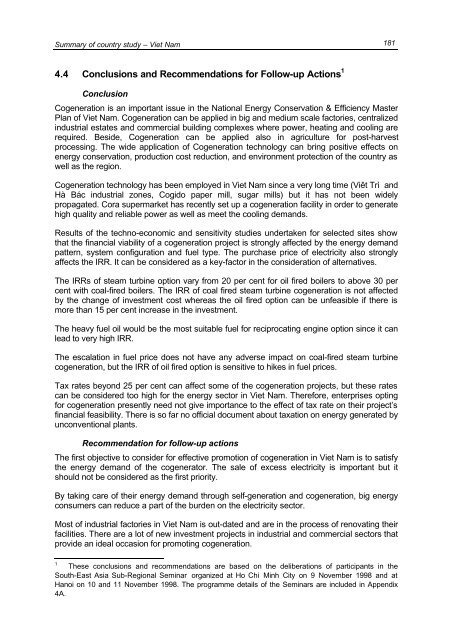part 1: overview of cogeneration and its status in asia - Fire
part 1: overview of cogeneration and its status in asia - Fire
part 1: overview of cogeneration and its status in asia - Fire
Create successful ePaper yourself
Turn your PDF publications into a flip-book with our unique Google optimized e-Paper software.
Summary <strong>of</strong> country study – Viet Nam<br />
4.4 Conclusions <strong>and</strong> Recommendations for Follow-up Actions 1<br />
Conclusion<br />
Cogeneration is an important issue <strong>in</strong> the National Energy Conservation & Efficiency Master<br />
Plan <strong>of</strong> Viet Nam. Cogeneration can be applied <strong>in</strong> big <strong>and</strong> medium scale factories, centralized<br />
<strong>in</strong>dustrial estates <strong>and</strong> commercial build<strong>in</strong>g complexes where power, heat<strong>in</strong>g <strong>and</strong> cool<strong>in</strong>g are<br />
required. Beside, Cogeneration can be applied also <strong>in</strong> agriculture for post-harvest<br />
process<strong>in</strong>g. The wide application <strong>of</strong> Cogeneration technology can br<strong>in</strong>g positive effects on<br />
energy conservation, production cost reduction, <strong>and</strong> environment protection <strong>of</strong> the country as<br />
well as the region.<br />
Cogeneration technology has been employed <strong>in</strong> Viet Nam s<strong>in</strong>ce a very long time (Viêt Trì <strong>and</strong><br />
Hà Bác <strong>in</strong>dustrial zones, Cogido paper mill, sugar mills) but it has not been widely<br />
propagated. Cora supermarket has recently set up a <strong>cogeneration</strong> facility <strong>in</strong> order to generate<br />
high quality <strong>and</strong> reliable power as well as meet the cool<strong>in</strong>g dem<strong>and</strong>s.<br />
Results <strong>of</strong> the techno-economic <strong>and</strong> sensitivity studies undertaken for selected sites show<br />
that the f<strong>in</strong>ancial viability <strong>of</strong> a <strong>cogeneration</strong> project is strongly affected by the energy dem<strong>and</strong><br />
pattern, system configuration <strong>and</strong> fuel type. The purchase price <strong>of</strong> electricity also strongly<br />
affects the IRR. It can be considered as a key-factor <strong>in</strong> the consideration <strong>of</strong> alternatives.<br />
The IRRs <strong>of</strong> steam turb<strong>in</strong>e option vary from 20 per cent for oil fired boilers to above 30 per<br />
cent with coal-fired boilers. The IRR <strong>of</strong> coal fired steam turb<strong>in</strong>e <strong>cogeneration</strong> is not affected<br />
by the change <strong>of</strong> <strong>in</strong>vestment cost whereas the oil fired option can be unfeasible if there is<br />
more than 15 per cent <strong>in</strong>crease <strong>in</strong> the <strong>in</strong>vestment.<br />
The heavy fuel oil would be the most suitable fuel for reciprocat<strong>in</strong>g eng<strong>in</strong>e option s<strong>in</strong>ce it can<br />
lead to very high IRR.<br />
The escalation <strong>in</strong> fuel price does not have any adverse impact on coal-fired steam turb<strong>in</strong>e<br />
<strong>cogeneration</strong>, but the IRR <strong>of</strong> oil fired option is sensitive to hikes <strong>in</strong> fuel prices.<br />
Tax rates beyond 25 per cent can affect some <strong>of</strong> the <strong>cogeneration</strong> projects, but these rates<br />
can be considered too high for the energy sector <strong>in</strong> Viet Nam. Therefore, enterprises opt<strong>in</strong>g<br />
for <strong>cogeneration</strong> presently need not give importance to the effect <strong>of</strong> tax rate on their project’s<br />
f<strong>in</strong>ancial feasibility. There is so far no <strong>of</strong>ficial document about taxation on energy generated by<br />
unconventional plants.<br />
Recommendation for follow-up actions<br />
The first objective to consider for effective promotion <strong>of</strong> <strong>cogeneration</strong> <strong>in</strong> Viet Nam is to satisfy<br />
the energy dem<strong>and</strong> <strong>of</strong> the cogenerator. The sale <strong>of</strong> excess electricity is important but it<br />
should not be considered as the first priority.<br />
By tak<strong>in</strong>g care <strong>of</strong> their energy dem<strong>and</strong> through self-generation <strong>and</strong> <strong>cogeneration</strong>, big energy<br />
consumers can reduce a <strong>part</strong> <strong>of</strong> the burden on the electricity sector.<br />
Most <strong>of</strong> <strong>in</strong>dustrial factories <strong>in</strong> Viet Nam is out-dated <strong>and</strong> are <strong>in</strong> the process <strong>of</strong> renovat<strong>in</strong>g their<br />
facilities. There are a lot <strong>of</strong> new <strong>in</strong>vestment projects <strong>in</strong> <strong>in</strong>dustrial <strong>and</strong> commercial sectors that<br />
provide an ideal occasion for promot<strong>in</strong>g <strong>cogeneration</strong>.<br />
1 These conclusions <strong>and</strong> recommendations are based on the deliberations <strong>of</strong> <strong>part</strong>icipants <strong>in</strong> the<br />
South-East Asia Sub-Regional Sem<strong>in</strong>ar organized at Ho Chi M<strong>in</strong>h City on 9 November 1998 <strong>and</strong> at<br />
Hanoi on 10 <strong>and</strong> 11 November 1998. The programme details <strong>of</strong> the Sem<strong>in</strong>ars are <strong>in</strong>cluded <strong>in</strong> Appendix<br />
4A.<br />
181









